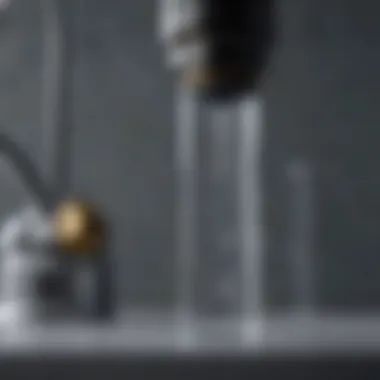Understanding Water Hardness Measurement Techniques


Intro
Water hardness is a term that often pops up in discussions about water quality. It refers to the concentration of dissolved minerals, mainly calcium and magnesium, in water. Understanding water hardness is crucial for a variety of reasons. For households, it impacts everything from the lifespan of appliances to the efficacy of soaps and detergents. In industrial contexts, it can affect processes, equipment, and product quality.
In this exploration, we will peel back the layers of water hardness measurement, shedding light on its principles, various techniques employed in measurement, and the far-reaching implications of water hardness on health and industry. As we dive deeper, keep in mind that both temporary and permanent hardness will be discussed, alongside methods of alleviating the issues that arise due to hard water.
Understanding Water Hardness
Understanding water hardness is essential for addressing numerous issues related to water quality, both for domestic use and in various industrial applications. Water hardness is not merely a scientific measurement; it influences everyday life, from the performance of household appliances to the longevity and efficiency of plumbing systems. Additionally, comprehending the nature of water hardness allows individuals and organizations to select appropriate treatment methods, thereby ensuring that water meets specific health and safety standards.
Definition of Water Hardness
Water hardness typically refers to the concentration of dissolved calcium and magnesium ions in water. These minerals come from the weathering of rocks and soils, making their presence in water a natural occurrence. The levels of these ions determine whether water is categorized as hard or soft. Hard water has high concentrations of these minerals, while soft water has low levels.
The measurement is usually expressed in milligrams per liter (mg/L) or parts per million (ppm) of calcium carbonate. The presence of these minerals affects not only the taste of the water but also its suitability for various uses. In residential contexts, hard water can lead to scaling in pipes and appliances, requiring more frequent maintenance. In some cases, this leads to costly repairs and diminished operational efficiency.
Temporary vs. Permanent Hardness
When exploring water hardness, it is critical to understand the distinctions between temporary and permanent hardness.
- Temporary Hardness: This type of hardness is primarily due to the presence of bicarbonate minerals, which are soluble in water. It can be largely addressed through boiling, which precipitates the bicarbonates as calcium carbonate, making the water softer.
- Permanent Hardness: On the other hand, permanent hardness is caused by sulfates and chlorides of calcium and magnesium. This form of hardness cannot be removed by boiling and requires chemical treatment or specialized water-softening methods, such as an ion-exchange system.
This differentiation is key for households and industries in deciding how to treat their water effectively, revealing a practical aspect of understanding water hardness that goes beyond scientific measurement.
Causes of Water Hardness
The causes of water hardness are diverse and often linked to geological factors in the region where the water is sourced.
- Geological Composition: Areas with limestone, chalk, or gypsum deposits typically have harder water. As rainwater filters through these geological formations, it can dissolve minerals, leading to increased hardness.
- Agricultural Runoff: Fertilizers and livestock waste can contribute to the mineral content of local water supplies. Nutrients leaching into groundwater can exacerbate hardness levels.
- Industrial Discharge: Wastewater from industrial processes can introduce various minerals into the water supply, often elevating hardness levels beyond natural occurrences.
- Environmental Changes: Climate changes can alter the hydrology of a region, impacting how minerals are mobilized and concentrated in water sources.
Being aware of these causes helps in adopting better management practices and strategies, particularly within water-sensitive oversight in households and industries.
Understanding the principles of water hardness provides a firm foundation for anyone seeking to manage water quality more effectively. It informs not only the necessary measurement techniques but also the broader implications of that hardness on overall health and infrastructure.
Measuring Water Hardness
When it comes to water quality, understanding and measuring hardness is crucial for both residential and industrial settings. Water hardness stems from dissolved minerals, primarily calcium and magnesium. These components have far-reaching implications that can affect health, plumbing systems, and manufacturing processes. Accurately measuring hardness not only aids in maintaining optimal water quality but also prevents the potential corrosion or scaling that can arise from untreated hard water.
Having a clear grasp of how hard water is assessed enables households and industries to implement effective mitigation strategies. This knowledge is key to managing costs and ensuring the longevity of plumbing systems, appliances, and equipment. Additionally, regulatory compliance often hinges on knowing water hardness levels, thereby further underscoring its significance in today’s context.
Importance of Accurate Measurement
The importance of accurate measurement of water hardness cannot be overstated. Inaccurate readings can lead to over-treatment or under-treatment, which can greatly affect the quality of life and operational efficiency. For example, using too much softening agent can unnecessarily inflate costs for households or businesses. Conversely, if the water remains untreated, it can lead to scaling in pipes or appliances, hindering their performance and lifespan.
Furthermore, regulatory bodies often require precise data for compliance with health and safety standards. Organizations like the Environmental Protection Agency set specific thresholds for hardness to protect consumers. In this light, having accurate methods of assessment aids in cutting through the noise of speculation and delivers actionable insights into water quality.
Common Methods of Measurement
Measurement techniques for water hardness predominantly fall into a few categories. Key methods employed include:
- Titrimetric Techniques: This is a popular manual method that measures ions in a solution through titration.
- Gravimetric Analysis: Often reserved for lab settings, this method quantifies hardness by precipitating dissolved minerals.
- Instrumental Techniques: Utilizing tools like spectrometers, these methods provide precise and often real-time measurements.


Each technique has its respective pros and cons, but the decision often hinges on the context — whether it be for industrial needs or domestic applications.
Titrimetric Techniques
Titrimetric assays serve as one of the fundamental ways to evaluate water hardness. In this process, a known concentration of titrant is added to a sample until the endpoint is reached, which can be noticed through changes in color from indicator substances. What’s unique about this method is the relative simplicity; no advanced equipment is necessary, making it accessible to many labs.
However, precision in technique is essential. An inexperienced hand can throw off results, leading to questionable data. Also, time taken to complete results might not be ideal for all scenarios. Thus, even though titrimetric techniques are effective, they should be chosen with consideration of the specific situation.
Gravimetric Analysis
Gravimetric analysis is another method that is often utilized in formal laboratory environments. It works by filtering out and weighing precipitated minerals from water samples. This can really give a clearer picture of the mineral content because you’re literally measuring the mass of what’s dissolved in your sample.
However, it is a time-consuming process. The results aren’t immediate and require careful balancing of various factors including evaporation and sample handling. Also, this method may not be optimal for routine checks where rapid assessments are crucial.
Instrumental Techniques
The advent of technology has introduced instrumental techniques for measuring water hardness, which offer unmatched precision and speed. Techniques such as ion chromatography and atomic absorption spectroscopy allow for near real-time data capture and delicate differentiation of various hardness-causing ions.
Though these methods come with higher costs due to the instrumentation required, they are becoming increasingly essential in ongoing research, regulatory compliance, and even in-home monitoring systems. The growing need for accurate data in various sectors is making instrumental techniques more relevant each day.
As you can see, the approaches to measuring water hardness vary greatly in context and application. Identifying the right method hinges on understanding the requirements at hand, whether for health, industry, or environmental compliance.
Implications of Water Hardness
Understanding the implications of water hardness is crucial because it extends far beyond just the quality of drinking water. It broadly influences public health, impacts infrastructure, and shapes industrial processes. The effects of hard water are multifaceted, encompassing both economic and health-related considerations. Here, we will delve deeper into each area, accentuating why awareness and management of water hardness is vital.
Health Effects of Hard Water
One primary concern regarding hard water centers on its health implications. While the consumption of minerals like calcium and magnesium found in hard water could be beneficial in moderate amounts, excessive hardness can pose challenges.
Research suggests that individuals living in areas with hard water may have a higher intake of these minerals, but it's not a straightforward benefit. There are instances where hard water may exacerbate certain health conditions, particularly skin-related issues such as eczema.
Potential effects include:
- Dry skin and irritation from soap not lathering well
- Increased risk of infections due to compromised skin barriers
Importantly, the collective exposure to hard water could intersect with dietary mineral intake, subtly affecting overall health. Therefore, while it's often deemed harmless, the nuances of an individual’s health should be considered when discussing hard water's impact.
Impact on Plumbing Systems
Another significant implication revolves around infrastructure—plumbing systems in residences and commercial establishments. Over time, hard water contributes to the formation of lime scale, which is symptomatic of mineral deposits. This scaling can wreak havoc on pipes and fixtures, leading to:
- Reduced water flow
- Increased energy costs due to inefficient heating systems
- Premature wear and tear on appliances
Plumbers spend substantial time addressing issues that typically arise from hard water. If left unchecked, the financial burden of repair and replacement gears up significantly because softeners and regular maintenance are often required. Hence, property owners must consider the type of water they’re using, as it directly correlates to the longevity of their plumbing systems.
Consequences for Industrial Processes
In industrial settings, water hardness can have dire consequences on both operations and product quality. Manufacturing processes—especially those involving steam generation or cold water cooling—can be severely affected. Depending on the industry, the presence of excessive hardness can lead to:
- Efficiency Losses: Equipment operating beyond optimal efficiency is not uncommon, leading to elevated production costs.
- Quality Issues: The presence of scale may contaminate products, which is detrimental in sectors like food processing or pharmaceuticals.
- Increased Downtime: Frequent maintenance interrupts production schedules, which can cripple delivery timelines.
In addition to not meeting quality standards, companies have to recalibrate their systems to address hardness problems, resulting in both time lost and unplanned expenses.


Hard water is not just a nuisance; it brings about systemic issues that require attention from both health and industry perspectives.
In summary, the implications of water hardness interlace diverse aspects of daily life and industry operation. Awareness of these factors not only informs personal choices on water consumption but also guides infrastructure investments and industrial practices.
Remedies and Management of Water Hardness
Managing water hardness is not just a matter of preference but rather a necessity for ensuring safe drinking water and optimal functionality in both home and industrial applications. Hard water, characterized by the presence of dissolved minerals like calcium and magnesium, can lead to various challenges, from scale buildup in plumbing to aesthetic issues in soap use. As we consider various methods to handle hard water, it’s important to deeply understand the remedies available, their effectiveness, and the considerations that come with them.
Water Softening Techniques
Water softening is probably the most well-known method for reducing water hardness. It primarily revolves around the principle of ion exchange. In essence, water softeners utilize a resin that exchanges sodium ions for calcium and magnesium ions. When hard water passes through the softener, the unwanted minerals adhere to the resin while sodium ions are released back into the water. This process effectively makes the water 'softer'. Here are a few specific points to consider:
- Effectiveness: Water softeners can drastically reduce hardness levels, making water more suitable for a variety of household tasks.
- Regeneration Process: It’s important to note that softeners need periodic regeneration, wherein a brine solution is flushed through the resin to refill sodium ions and remove accumulated hardness minerals.
- Cost and Maintenance: While the initial investment in a water softener can be significant, maintenance and operation costs should also be accounted for. Regular salt refills, for instance, can add up over time.
"Softened water improves detergent effectiveness, leading to lower soap and energy costs while reducing scale buildup."
Reverse Osmosis Systems
Reverse osmosis (RO) systems provide another effective avenue to combat hard water. They work by forcing water through a semi-permeable membrane that filters out nearly all dissolved solids, including those responsible for hardness. Here are the nuances of RO systems:
- Purity: RO systems not only reduce hardness but can also eliminate a variety of contaminants from the water, resulting in high-quality drinking water.
- Waste Production: One downside is the production of wastewater; for every gallon of permeate water, several gallons may be wasted, a consideration especially pertinent in water-scarce areas.
- Energy Use: Operating an RO system can require substantial energy, which may influence its feasibility for widespread household use.
Ion Exchange Processes
The ion exchange method isn't just reserved for water softeners; it has a broader application in various treatments for water hardness management. It involves the exchange of ions in the water with ions from a resin. Key points concerning ion exchange include:
- Widespread Use: This method is utilized in different scenarios, including in industrial processes where water quality is paramount.
- Chemical Requirements: Depending on the type of resin used, chemical additives may be required to maintain optimal performance and longevity of the system.
- Cost Considerations: The cost-effectiveness of ion exchange can vary widely based on water availability and type of resin used, thus requiring thorough analysis based on specific needs.
In summary, managing water hardness is crucial for various stakeholders, from households wanting to maintain the quality of their water to industries looking to ensure efficient operations. Each method of remedy, whether through water softening, reverse osmosis, or ion exchange, comes with its own set of benefits and challenges. The decision will often depend on individual goals and circumstances, weighing factors like initial cost, ongoing maintenance, and desired water quality.
Regulatory Standards and Guidelines
Regulatory standards and guidelines play a pivotal role in the field of water hardness measurement. These frameworks establish parameters that ensure the safety, quality, and reliability of water sources for various applications — be it consumption, agriculture, or industrial use. Their significance extends beyond mere compliance; they inform best practices that safeguard public health and environmental integrity.
At the core of these regulations are established methods for measuring water hardness, which not only aid in understanding the chemical makeup of water but also assist in the formulation of effective water treatment solutions. Adherence to these guidelines ensures that data collected regarding water hardness is both reliable and reproducible across different settings and locations. For organizations and facilities dealing with water, following these standards is not only about meeting regulations but also about fostering trust and transparency with stakeholders and consumers.
"The adoption of regulatory standards ensures that water quality assessments are accurate, reliable, and universally recognized."
In short, regulations provide a necessary backbone to the multidimensional approaches required for effective water management and conservation strategies.
National Standards for Water Hardness
National standards for water hardness vary from one country to another, reflecting both regional water quality concerns and regulatory frameworks. In many jurisdictions, these standards are set by governmental bodies or health agencies tasked with safeguarding public health. For instance, the United States Environmental Protection Agency (EPA) has guidelines for various water quality parameters, including hardness, which helps ensure the safety of drinking water across the nation.
Benefits of having national standards include:
- Health Protection: Establishes minimum and maximum allowable levels of hardness to prevent adverse health effects.
- Uniformity: Creates a consistent framework across different states and regions, simplifying compliance and enforcement.
- Consumer Awareness: Informs the public about the quality of their drinking water and its implications for health.
However, it's important to note that while the national standards are critical, they can sometimes be overlooked or inadequately enforced, leading to potential risks. Thus, it’s in everyone's best interest—citizens, environmentalists, and policymakers alike—to monitor and advocate for stringent adherence to these standards.
International Guidelines
International guidelines provide a broader, more global perspective on water hardness measurement and management. Organizations such as the World Health Organization (WHO) set recommendations that countries can adopt to maintain water quality across borders. These guidelines typically address both the health-related implications of water hardness as well as its influence on industrial processes.


Key aspects of international guidelines include:
- Harmonization: Facilitating consistency in water quality measures internationally, allowing for better comparative studies and data sharing.
- Best Practices: Promoting effective methods for water quality management and introducing innovative technologies for measurement and treatment.
- Cultural Sensitivity: Recognizing that different regions may have unique water quality challenges, thus advocating for tailored approaches that fit local contexts.
Aligning national measures with international guidelines can offer a more comprehensive picture of water hardness and its implications. By ensuring that countries understand and implement these guidelines, we can collectively work toward improving water quality worldwide.
Emerging Technologies in Water Hardness Measurement
Measurement of water hardness has, for long, relied on laboratory techniques that, while precise, can be cumbersome and time-consuming. In an era where instant information is expected, embracing emerging technologies has become paramount. These new methodologies not only aim to enhance accuracy but also provide practical benefits like real-time tracking and remote monitoring.
Novel Sensor Technologies
With advancements in material science and engineering, novel sensor technologies have emerged as pivotal tools in assessing water hardness. These sensors are typically designed to afford continuous monitoring and offer timely data on water quality.
For instance, developing materials such as polymer membranes or nanostructures have enabled the creation of sensors that are both sensitive and selective to the ions responsible for hardness, namely calcium and magnesium. The essence of these technologies lies in their ability to work synergistically with existing water systems, often requiring minimal alteration.
- Robust Performance: Novel sensors exhibit high resistance to physical and chemical interferences, meaning they can perform under fluctuating environmental conditions. This robustness makes them suitable for a range of applications, from domestic water systems to large-scale industrial processes.
- Instant Data: These devices provide immediate results, which is significant in processes where quick decision-making is critical. For example, a manufacturing setup that must ensure the hardness of water for specific processes can benefit immensely from these technologies that give instant feedback.
- Cost Efficiency: Although initial investments in such technologies might be higher, over the long run, they can reduce overall costs by minimizing downtime associated with water quality issues.
"The integration of smart sensor technology in water hardness measurement signifies a transformative step towards sustainability and efficiency."
Real-Time Monitoring Solutions
Real-time monitoring solutions represent a leap forward in maintaining optimal water conditions and managing hardness efficiently. Traditional approaches often entail periodic testing, which can miss transient changes in water quality. Hence, the need for real-time systems can’t be overstated.
These solutions not only furnish data but can also integrate with online dashboards, allowing users to visualize trends in water hardness over time.
Benefits of this approach include:
- Continuous Oversight: Constant monitoring can provide alerts if hardness levels exceed predetermined thresholds, enabling quick corrective actions.
- Data Integration: Many of these solutions can merge with IoT (Internet of Things) systems, gathering a myriad of data on water chemistry parameters that highlight broader trends in water quality.
- User-Friendly Interfaces: Modern solutions often come equipped with intuitive user interfaces, ensuring that even those with minimal technical knowledge can interpret the data easily.
With these advancements, industries dependent on high-quality water, like pharmaceuticals or food processing, have an unparalleled opportunity to harness data for better decision-making, ultimately improving their operational efficacy.
Future Directions in Water Hardness Research
Water hardness measurement is evolving rapidly, driven by the demand for more precise and effective strategies to manage water quality. This pursuit isn't just about tapping into the latest technologies; it reflects a broader understanding of water's vital role in various societal domains, spanning health, environmental sustainability, and industry. Recognizing the implications of hardness in both natural and treated waters can guide better practices and ensure safe usage.
Innovative Measurement Techniques
One cannot overstate the significance of cutting-edge measurement techniques that are emerging to assess water hardness. Traditional methods, like titration, while effective, often face limitations in speed and accuracy, especially in complex matrices. New technologies like optical sensors and portable ion-selective electrodes offer a refreshing alternative. These tools can provide real-time data on hardness, allowing for timely decision-making regarding water treatment.
Some promising approaches include:
- Optical Sensors: Utilizing light reflection or absorption to quantify hardness levels, these sensors show potential for continuous monitoring in various settings—from residential areas to large-scale industries.
- Microfluidics: This innovative technology involves manipulating small volumes of fluids to conduct rapid tests, which can detect hardness levels almost instantaneously.
- Machine Learning Algorithms: With the integration of AI, predictive models can now assess how various factors influence water hardness, offering insights that can shape future research and practical applications.
Adopting these techniques not only enhances measurement accuracy but also paves the way for smarter water management solutions. If we can measure accurately, we can manage effectively. This becomes particularly important in areas where water quality fluctuates significantly.
Impact of Climate Change on Water Hardness
Climate change presents challenges that are gradually rewriting the narrative of water quality. As global temperatures rise, we see shifts in precipitation patterns and increased evaporation rates. These changes can lead to a variation in mineral composition in natural water sources, thus affecting hardness levels.
Here are a few considerations regarding the impact of climate change on water hardness:
- Altered Rainfall Patterns: Increased droughts or excessive rainfall can concentrate or dilute hard minerals in water sources, respectively. When the rain falls less frequently, it can leave behind higher concentrations of calcium and magnesium in groundwater.
- Temperature Effects: Warming waters can lead to increased solubility of certain minerals, potentially altering hardness levels in unexpected ways.
- Ecosystem Responses: Changes in climate also affect local ecosystems, which can influence water chemistry. For instance, alterations in vegetation and soil composition can change how minerals leach into waterways.
The research community faces a pressing need to understand these dynamics better. By delving deeper into how climate is affecting water hardness, we can develop strategies not only for remediation measures but also predict future water quality scenarios under varying climatic conditions.
"Our understanding of water hardness must evolve as swiftly as the climate is changing if we are to sustain our resources for future generations."
As students, researchers, and professionals explore these future directions, the synergy between technology and environmental science will undoubtedly play a key role in shaping effective water management policies. Keener awareness and innovative practices will be essential as we navigate the complexities of water hardness in a warming world.



